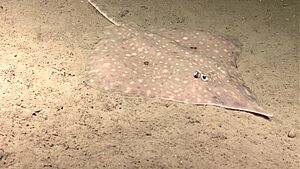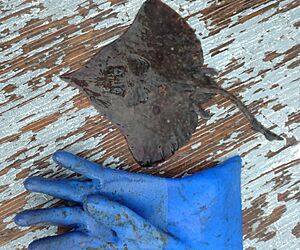Longnose skate facts for kids
Quick facts for kids Longnose skate |
|
|---|---|
 |
|
| A longnose skate near Santa Cruz Island in 2011 | |
| Conservation status | |
| Scientific classification | |
| Synonyms | |
|
The longnose skate (scientific name: Beringraja rhina) is a type of skate. Skates are fish that are related to sharks. This skate lives in the northeast Pacific Ocean.
You can find the longnose skate from the eastern Bering Sea and Alaska all the way down to Baja California and the Gulf of California. These skates live in deep waters. They are often found between 9 and 1,069 meters (about 30 to 3,500 feet) deep.
Scientists recently moved the longnose skate into a new group, called Beringraja. Before this, it was part of the Raja group. This change happened because of new information from genetic studies. However, some people still use the old name, Raja rhina.
What Does a Longnose Skate Look Like?
The longnose skate gets its name from its long, pointed snout. It also has special fins near its tail called pelvic fins, which have deep notches.
These skates can grow quite large. The biggest ones ever found were about 1.8 meters (nearly 6 feet) long! That's taller than most people.
Scientists can figure out how old a skate is by looking at its vertebrae (backbones). They count the growth rings, just like counting rings on a tree. The oldest longnose skates found were about 25 years old in the Gulf of Alaska and 26 years old in British Columbia.
Where Longnose Skates Live
Longnose skates prefer to live in deep parts of the ocean. They are often found on the upper slopes of the continental shelf. This is where the land under the ocean starts to drop off steeply.
They like areas with a lot of sand or mud. They also live near rocky places and areas with special carbonate crusts. These skates like water temperatures between 3 and 6 degrees Celsius (about 37 to 43 degrees Fahrenheit).
Scientists learned a lot about where these skates live from a big study in 2019. It was the first long-term study of skates in the deep waters of the eastern North Pacific.
Reproduction and Life Cycle
Longnose skates lay their eggs in special cases. These egg cases are large and smooth. They have wide, webbed edges on both ends.
The egg cases can be up to 15 centimeters (about 6 inches) long and 12 centimeters (about 5 inches) wide. Inside these cases, the baby skates grow until they are ready to hatch.



